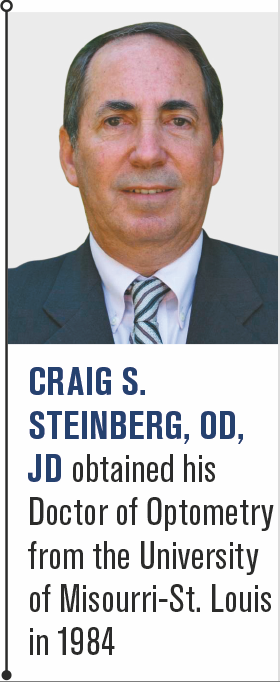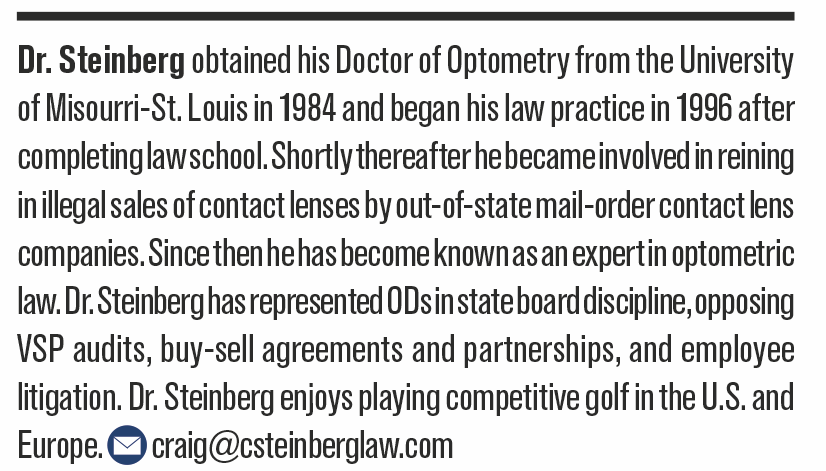New CA law affects all VSP providers



As happens every Jan. 1, new laws go into effect. One that will impact every contracted Vision Service Plan (VSP) provider-that most don’t even realize affects them-is a change in the California Health and Safety Code.1
This change affects all VSP providers because the VSP contract (called the Network Provider Agreement or NDA) states that California laws apply to the VSP contract.
So, what’s this new law all about and why does it matter?
Sampling now legal
For many years, when VSP’s special investigations unit (SIU) audited a doctor, SIU investigators examined about 40 records drawn from a three-year period. Investigators then used that sample to extrapolate out how much they believed the doctor had been overpaid and owed back to VSP, based on three years’ worth of patients.
This sampling and extrapolation process could turn relatively small errors into very large, even six-digit, repayment demands.
In fact, VSP was not authorized by state regulators to use this sampling process.2 In response to a complaint, the California Department of Managed Health Care instructed VSP that the company could not use sampling/extrapolation without statutory authority.2 This means the process cannot be used unless a law allows it.
Thus, VSP set out to obtain that authority by introducing a bill in the California legislature. That new law was eventually passed, and it took effect Jan.1, 2019.2
3 reasons why important
This law is important for three reasons.
First, the new law allows VSP to use sampling and extrapolation, provided its statistical methods are “reliable.”
Related: Know the legal aspects of myopia control
Second, VSP audits can no longer go back three years. The new law limits the company to going back only one year in its audits.
Finally, during the time VSP was pursuing the law, its auditing of contracted providers appeared to nearly stop. However, with the new law in place, optometrists should expect VSP to begin once again auditing its providers.
Conduct a self-audit
There are a number of steps that every VSP contracted doctor can take-some which should be done at least once every year-to help reduce the risk of being audited and increase the possibility that, if they are audited, they will pass.
Number one among those things is obvious, yet rarely done: Make sure you and your staff are not and have not been violating VSP’s rules.
With that in mind, here are suggestions for a self-audit:
• Your records must include contact lens fitting information if you billed for contact lens professional services. Don’t bill VSP for a fitting or contact lens service if you didn’t perform a contact lens fitting and simply drop-shipped new contact lenses to the patient. If billing for contact lens-related professional services, your records should reflect that you actually checked the patient’s eyes with the lenses, including over-refraction, visual acuities, and an evaluation of the fit through the slit lamp. You should also document the patient’s lens care and wearing schedule.
Related: States fighting to advance optometry
• Your records must indicate the dispensing of materials. Though not clearly stated in the VSP manual, VSP expects ODs to record the date materials are dispensed and, for contact lenses, exactly what was dispensed (type and quantity).
• Make sure the fees you charge VSP are the same as the fees you charge cash patients. You cannot have two sets of fees. VSP representatives have called practitioner offices acting as a prospective patient to ask about fees. Then, VSP will compare what the staff quotes with what is billed to VSP as the doctor’s “usual and customary fee.”
• Check that your price list is updated and matches what you charge to VSP. This dovetails with the prior point. VSP may ask for your price list. If what you provide is old with lower fees than what you are billing to VSP, that’s a red flag.
• If you have opted out of using VSP labs in states where this is permitted, make sure your progressive spectacle lens type is billed correctly. If you are using a lab-brand lens, VSP requires it be billed at the lowest reimbursed level, a “K” lens.
• All doctors in the practice who see VSP patients must be VSP credentialed. If a doctor doesn’t appear on the drop-down box when billing VSP, work to get the doctor immediately credentialed with VSP.
• Make sure there is no benefit switching among patients (using one spouse’s benefits for the other spouse’s contact lenses, for example.). In my experience working with ODs audited by VSP, it is not unusual in an unannounced audit to discover a Post-It note stating to use the benefits for a relative.
• Make sure that the patient’s record shows that contact lenses were ordered and dispensed if you billed for contact lenses. VSP looks for cases in which contact lenses were billed, but the money was used for glasses or non-prescription sunglasses.
Related: 10 tips to surviving an insurance audit
• This is important: If you billed for visually necessary contact lens (VNCL), make sure your fees are based on lens type and complexity and not on the fact that it is VNCL (you generally cannot charge VSP a higher fitting fee for a -10.00 D lens than you do for a -9.50 D lens just because the -10.00 D qualifies as VNCL ).
• If using electronic health records (EHR), make sure the records are properly completed, finalized, and closed. Some EHR systems do not print a complete record until the record is closed.
• Test your EHR system. Print some records to ensure that all exam information prints out. Be sure you and your staff know how to print a complete record of a patient visit.
Know the rules
Spend time printing out and browsing through the most current Provider Reference Manual. This is available on the Eyefinity website under VSPOnlineï Manualsï VSP.
VSP updates the manual during the year, so use a yellow highlighter to identify things in the manual that seem new to you or important for your staff to know. You might even discover that you’re not taking full advantage of all the benefits available.
Most importantly, once an auditor is in your office, it’s too late to protect yourself from a bad audit outcome. Start now.
If an auditor shows up, be polite. Be respectful. Do your best to provide everything the auditor asks for and anything else you think might be helpful to the auditor in showing you are complying with VSP rules. For example, provide material invoices and test results recorded on separate devices like a topographer or optical coherence tomographer (OCT).
Related: Optometry must change with the times
Finally, VSP audits are serious and can have serious consequences. Take them seriously. If you are audited and you don’t receive the outcome you expected, you have rights to appeal the audit. VSP auditors may be overzealous. Get help for an appeal. Find someone with experience at challenging VSP audits-don’t try defending yourself without help; that usually doesn’t go well-and take advantage of VSP’s appeals process because it may result in a better outcome.
References:
1. Health and Safety Code Division 2, Chapter 2.2 Health Care Service Plans.
California Legislative Information. Available at: https://leginfo.legislature.ca.gov/faces/codes_displaySection.xhtml?lawCode=HSC§ionNum=1371.1. Accessed 1/7/19.
2. AB-1092 Health care service plans: vision care services: provider claims: fraud. California Legislative Information. Available at: https://leginfo.legislature.ca.gov/faces/billTextClient.xhtml?bill_id=201720180AB1092. Accessed 1/7/19.

Newsletter
Want more insights like this? Subscribe to Optometry Times and get clinical pearls and practice tips delivered straight to your inbox.